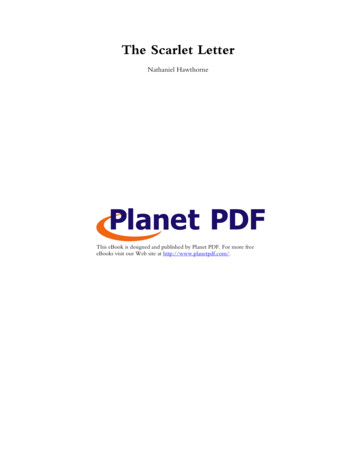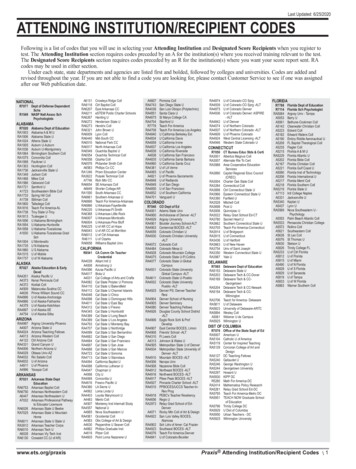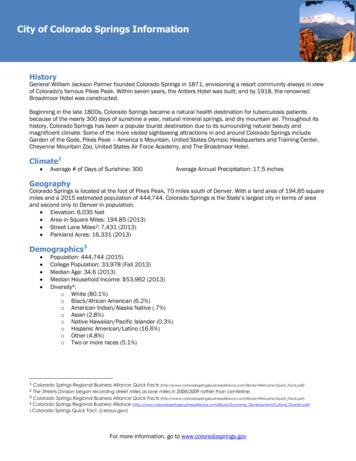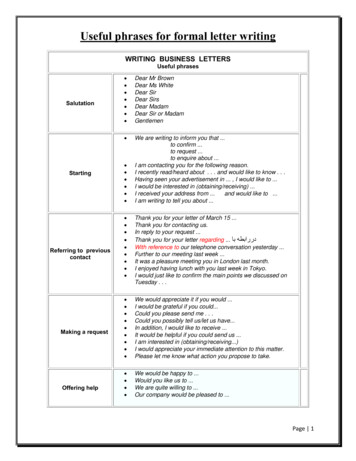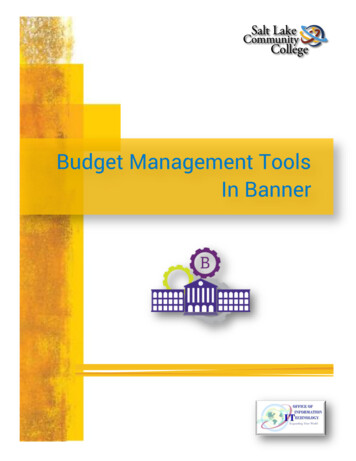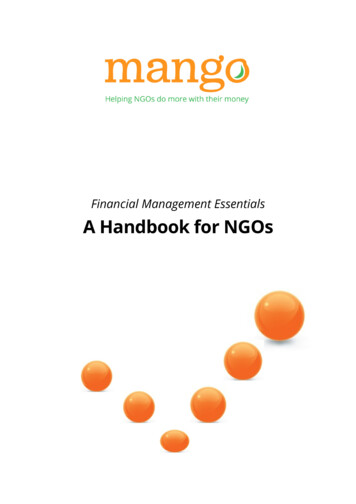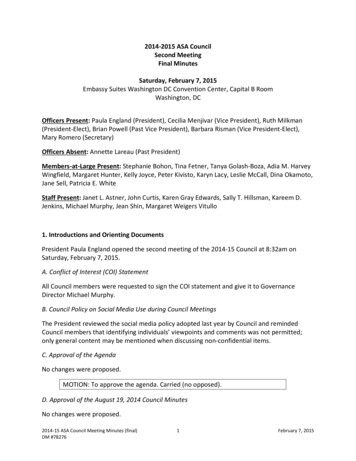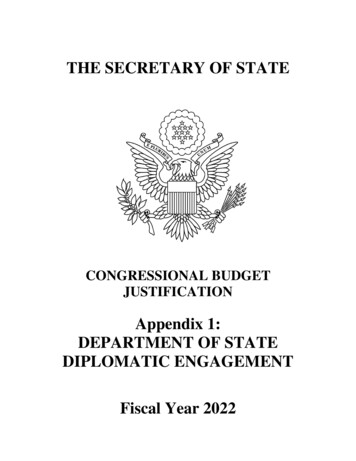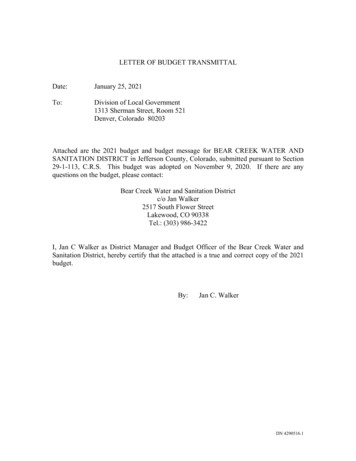
Transcription
LETTER OF BUDGET TRANSMITTALDate:January 25, 2021To:Division of Local Government1313 Sherman Street, Room 521Denver, Colorado 80203Attached are the 2021 budget and budget message for BEAR CREEK WATER ANDSANITATION DISTRICT in Jefferson County, Colorado, submitted pursuant to Section29-1-113, C.R.S. This budget was adopted on November 9, 2020. If there are anyquestions on the budget, please contact:Bear Creek Water and Sanitation Districtc/o Jan Walker2517 South Flower StreetLakewood, CO 90338Tel.: (303) 986-3422I, Jan C Walker as District Manager and Budget Officer of the Bear Creek Water andSanitation District, hereby certify that the attached is a true and correct copy of the 2021budget.By:Jan C. WalkerDN 4290516.1
BEAR CREEK WATER AND SANITATION DISTRICT2517 SOUTH FLOWER STREETLAKEWOOD, CO 80227-2912(303) 986-3442 OFFICE(303) 986-8213 rCreekWater.org/BEAR CREEK WATER AND SANITATION DISTRICT2021 BUDGET MESSAGEJANUARY 1, 2021, THROUGH DECEMBER 31, 2021ADOPTED BY THE BOARD OF DIRECTORSAT THEIR REGULAR MEETING HELD ONDECEMBER 14, 2020MISSION STATEMENTOUR MISSION IS TO PROVIDE PUBLIC WATER AND SANITARY SEWERSERVICES TO THE TAXPAYERS AND RATEPAYERS OF BEAR CREEKWATER AND SANITATION DISTRICT IN A SAFE, EFFICIENT,COST-EFFECTIVE AND SUSTAINABLE MANNER, WHILEMEETING ALL STATUTORY AND REGULATORY REQUIREMENTS.1
BEAR CREEK WATER AND SANITATION DISTRICTBUDGET MESSAGE FOR FISCAL YEAR 2021The Board of Directors of Bear Creek Water and Sanitation District [Bear Creek or District], attheir regular meeting held December 14, 2020, adopted the 2021 Annual Budget. The AdoptedBudget and related Resolutions are attached hereto in the Appendices and made a part of thisdocument. This 2021 Annual Budget has been prepared pursuant to Colorado Revised Statutes,Titles 29 and 32. The budget is one of the most important documents produced each year by theDistrict. It is a policy document, financial plan, operations guide, and communications tool. Itshows where the funding comes from, how it is used for services provided and the cost of services.The District.Bear Creek Water and Sanitation District is a quasi-municipal corporation and politicalsubdivision of the State of Colorado, established in August 1962 under the laws of the State ofColorado Special District Act [Colorado Revised Statutes, Title 32]. Bear Creek was organizedfor the purpose of serving public water and sanitary sewer utilities to the properties and people ofthe District.Location.The District Office is located in a residential area within the District boundaries at 2517 SouthFlower Street, Lakewood, Colorado 80227-2912. Official business hours are from 8:00 a.m. to5:00 p.m., Monday through Friday, except for holidays. Due to the COVID-19 situation, theDistrict office has been closed to visitors since March 2020. You may contact the District Officeby telephone (303) 986-3442, fax (303) 986-8213 or E-mail atbearcreekwater@bearcreekwater.org.Service Area.Most of Bear Creek’s service area is situated within the City of Lakewood, Colorado. Portionsof the District are located in unincorporated Jefferson County. The District encompassesapproximately four-square miles and serves a population of approximately 32,509. An estimatedpopulation of over 38,086 is projected at ultimate development of the District.Public Water and Sanitary Sewer Systems.The District owns and maintains the public water distribution system and the public sanitarysewer collection system. Bear Creek has a comprehensive Operations and Maintenance (O&M)Program in place. A systematic, proactive method of managing and improving the performanceand quality of the public systems is pursued by implementing best practices of the industry.The O&M program includes scheduled inspections, repairs and maintenance, predictions ofproblematic areas, taking preventative measures, and planning upgrades or replacement of theinfrastructure in advance of potential problems. Upon discovery or notification of any problem inthe public systems, Bear Creek’s O&M contractor, C&L Water Solutions, Inc., responds quicklyto restore the public water or sanitary sewer systems to fully operable conditions. All elements ofthe public water and sanitary sewer systems are tracked on a Geographical Information System(GIS) and a Geophysical Positioning System (GPS) program and are integrated with the District’sdatabases of the public, private and adjacent water and sanitary sewer systems. Databases alsoinclude locations, improvements, repairs, maintenance, inspections, emergencies, criticalincidents, tap records, historic O&M activities and other related records and information fortracking, controlling and reporting activities of the public systems and appurtenances thereto.2
Public Water Services. Bear Creek Water and Sanitation District is a water distributor of DenverWater under Read and Bill Water Service Agreement No. C200. Denver Water provides the watersupply and controls the sale, setting and reading of water meters. Denver Water bills the District’scustomers based on Read-and-Bill water rates established by the Denver Board of WaterCommissioners. At present, Bear Creek serves approximately 4,138 single family residentialequivalent (SFRE) water taps. A total of 5,152 SFRE water taps is anticipated at build-out of theDistrict.Sanitary Sewer Services. Wastewater flows by gravity from the connectors in the District throughthe District’s public sanitary sewer collection lines to the Robert W. Hite Treatment Facility of theMetro Wastewater Reclamation District (MWRD) for treatment. This sewage treatment isprovided under a Connectors Agreement between MWRD and Bear Creek. At present, Bear Creekserves approximately 8,590 single family residential equivalent (SFRE) sanitary sewer taps. BearCreek bills sewer use fees to the District’s customers to recover the District’s expenses for sewagetreatment charges paid to MWRD, the cost of billing, operations and maintenance and plannedcapital improvement projects.Water and Wastewater Activities Enterprise. The District, as a General Government, owns andoperates a Water and Wastewater Activities Enterprise pursuant to Article 1, Title 32 of the 1973Colorado Revised Statutes, as amended, Article X, Section 20 of the Colorado State Constitution—Taxpayers’ Bill of Rights (TABOR), and Colorado Revised Statutes Title 37 Article 45.1 (SenateBill 93-130). Although the Enterprise is exempt from most TABOR limitations, there are certainlimits on the use of General Government funds.BOARD OF DIRECTORSBoard of Directors. A five-member Board of Directors is the governing body of the District.The Directors of Bear Creek adopt Resolutions to set rules, regulations and policies and otherofficial actions for governance of water and sanitary sewer services for its customers and tooperate, maintain, repair, extend and replace the public water and sanitary sewer infrastructure.Each Director is generally elected to a four-year term (This will change to a three-year term forelections to be held in 2020 and 2022 only). The electorate of the District eliminated term limitsfor the Board of Directors at an election held on May 4, 2004.The compensation for special district directors is set by Colorado Revised Statutes32-1-902(3)(a)(II) at no more than 100 for each meeting attended and not to exceed 2,400 peryear.Regular meetings of the Board of Directors are held on the second Monday of each month at 7:00p.m. at the District Office, 2517 South Flower Street, Lakewood, CO 80227-2912. Due to theCovid-19 Situation and State of Colorado and CDPHE orders and recommendations regardingpublic meetings, the 2020 Board Meetings have been held using the Zoom Meeting Application.The 2021 Meetings will also be held on the Zoom Meeting Application until the Covid-19 situationimproves.A list of the regularly scheduled monthly Board Meetings is posted on the District website atwww.bearcreekwater.org, the entry of the District office located at 2517 South Flower Street,Lakewood, CO 80227 and at the Office of County Clerk and Recorder of Jefferson County.2021 Board of DirectorsDale L. MillerNeil A. JohnsonBarbara J. CoriaLinda M. LarssonSamuel E. HundleyChairman/PresidentVice Chairman/Vice-PresidentBoard TreasurerDirectorDirector3Nov. 2007 to May 2023Aug. 2018 to May 2022Oct. 2011 to May 2022Aug. 2018 to May 2022May 2020 to May 2023
FINANCIAL ATTRIBUTESFinancial StructureThe District's financial fiscal year begins on January 1st and ends on December 31st of eachyear. The District uses the modified accrual basis of accounting. The accounts of the District areorganized and presented to conform to generally accepted accounting principles (GAAP) appliedto a governmental unit operated as a single enterprise fund in accordance with Colorado RevisedStatutes. Enterprise accounting—also known as single-fund accounting—is used to record theoperations of governmental units which are financed and operated in a manner similar to privatebusiness enterprises. [Note: The term enterprise is applied differently in conjunction with theTABOR Amendment to identify exempt operations under the District’s Water and WastewaterActivity Enterprise.] The Annual Budget is prepared on cash basis. The cash-basis budget is talliedon the last page of budget spreadsheets to show TABOR compliance.The costs of administration of the District are covered by general property taxes and other generalfees and charges. Capital improvements are funded by investment income and permit fees for waterand sanitary sewer tap connections, as well as reserve funds that have been accumulated over thepast 35 years.Water and Wastewater Activities Reserve FundsA Water and Wastewater Activities Enterprise was established in 1993 for the purpose ofexempting the public water and sanitary sewer activities and the District’s reserve funds fromTABOR Amendment restrictions. The District has accumulated reserve funds to systematicallyupgrade or replace the public water and sanitary sewer systems and to preserve the future viabilityand sustainability of the District. Reserve funds are derived from interest earnings on investmentsand tap permit sales. These reserve funds are not restricted for specific purposes, they are usedgenerally for replacement or rehabilitation of public systems and other budgeted capital projectswhen annual income does not cover those capital expenses. Budgeted capital projects includeneeded improvements identified in the Operations and Maintenance Program, replacement ofpublic lines scheduled in the Master Plan and other capital projects to address current and longterm needs.In February 2017, the Bear Creek Water and Sanitation District (District) engaged RaftelisFinancial Consultants, Inc. (RFC) to complete a Water and Sewer Rate Study (Study) that analyzedthe financial status of the District and identified the revenue adjustments needed to support theDistrict’s continuing financial viability. The District engaged RFC to provide an update to the2017 Rate Study in 2019. A copy of the Final Bear Creek Water and Sanitation District RatesStudy Reports dated July 10, 2017 and August 6, 2019, respectively, are available to the public.Please contact the District Manager to receive copies by mail or e-mail.In 2019, the District engaged an external consultant, Christina Griggs of GEMSBOKConsulting to develop a fiscal planning tool in 2020 to assist the District in long-term planning,budgeting and to determine an appropriate minimum reserve amount to be held towards the futurecapital needs of the DistrictInasmuch as the District should be able to cash fund its capital improvement and replacementprogram, the issuance of bonds, applications for grants or other methods of financing capitalimprovements may be considered at any time. Long-range financial projections are revisitedperiodically for adjustment to the set of assumptions, to consider new technology or industrystandards, to reset projected life spans of repaired or rehabilitated lines and to adjust for otheroccurrences that may affect the projections.4
.Prepayment of Conduit Participation ChargesIn December 2001, the District invested 418,600 of Water and Wastewater Activities Reservefunds by prepaying conduit participation charges, as provided by the October 1985 Agreementwith Denver Water. For water source and supply, Bear Creek shares the operation andmaintenance as well as capacity in Denver Water’s Kendrick conduit, pump station, reservoir anddistribution system with Green Mountain and Bancroft-Clover Water and Sanitation Districts. Byprepaying these participation charges, the District secured an interest in 700 single-familyresidential-equivalent (SFRE) water taps. There is a conditional guarantee of water supply to buildout in the District’s Water Service Agreement with Denver Water. Prepaid participation charges,plus an amount in lieu of interest income, are collected along with sales of the District’s water tappermits. The total amount collected per SFRE tracks Denver Water’s current charge for conduitparticipation. [The difference between Denver’s charge and Bear Creek’s charge represents theDistrict’s return on investment]Development PolicyThe District requires all developers or individual property owners to cover the cost ofconstruction to extend the public water and sanitary sewer systems, including expenses incurredon behalf of the developments for legal and engineering services, and the costs of filing andrecording associated documents. Developments must be consistent with the District’s MasterDevelopment Plan, Rules and Regulations and other local, county, state and federal standards thatmay be applicable.Annual External AuditThe District’s basic financial statements for 2019 were audited by the firm of Crady Puca &Associates. Upon review by the Office of the Colorado State Auditor and in the opinion of theexternal auditors, no exceptions have been taken to the District’s financial statements.Following a Request for Proposals for audit service, the District engaged the firm of Crady,Puca and Associates to conduct the audit of the basic financial statements for the year endingDecember 31, 2014. This engagement was renewed for the audit years ending 2015, 2016, 2017,2018, 2019 and 2020. At the Treasurer’s discretion, this agreement may be renewed for the 2021audit as well, after which requests for proposals may be produced again.Bond Interest, Bond PrincipalOutstanding General Obligation Water Refunding Bonds, Series 92, were redeemed inDecember 1999, leaving the District with no outstanding debt. Bear Creek does not anticipatebonded indebtedness in the foreseeable future. Presently, capital projects are cash-funded fromthe District’s Water and Wastewater Activities Reserve Fund. However, the issuance of bondsmay be considered at any time for financing capital improvements.Non-Financial Goals and ObjectivesPolicies, procedures and master plans are in place to cover non-financial functions, includingbut not limited to District Office activities, human resources, field operations, safety, vulnerability,sustainability, public relations, and master plans for development of the District and expansion ofthe public water and sanitary sewer systems. However, it is understood that all policies affect theDistrict’s finances and these effects are considered in the budget preparation and financialreporting processes.5
LIMITATIONS ON GENERAL PROPERTY TAXES AND SPENDINGStatutory 5.5 percent Limit on General Property TaxesA Statutory limit on general property tax revenue, also known as the "Annual Levy Law"(Colorado Revised Statutes §29-1-301) restricts the District’s levy of general property tax revenueto an amount no greater than was levied in the preceding year plus five and one-half percent(5.5%).Constitutional Amendment Limitation on General Property Taxes and SpendingThe electors of Colorado passed the Taxpayer's Bill of Rights (TABOR) Amendment to ArticleX, Section 20 of the State Constitution at Election in 1992. TABOR defines an enterprise as agovernment-owned business authorized to issue its own revenue bonds and which receives nomore than ten percent (10%) of its annual revenue in grants from all state and local governmentscombined. Subsequently, Senate Bill 93-130, was adopted into law during the 1993 session of theColorado State Legislature (Colorado Revised Statutes §37-45.1), to clarify TABOR language andprovide for exemptions for water and sanitation districts.There are two TABOR limits on general property tax:Revenue Limit. The revenue limit is reached by adjusting the previous year’s certified generalproperty tax revenue by growth and the estimated Boulder-Denver-Greeley CPI for 2020.Mill Levy Rate Limit. The Rate limit is a factor of the assessed valuation multiplied by theprevious year’s rate.Also, there is a TABOR limit on spending, which is actually a revenue-driven annual limit.General Government Spending Limit. TABOR provisions allow an increase of no more thangrowth plus CPI over the previous year’s revenue.Application of Limits to Annual BudgetUpon applying the limitations described above and calculating the 2020 general property taxlevy for collection in 2021, statutory 5.5% limit was most restrictive with growth at 15.503 % plusthe estimated Boulder-Denver-Greeley CPI for 2020 at 1.833%.The actual Boulder-Denver-Greeley CPI is released early in the year [2021] for the prior year[2020]. At that time, TABOR limits are recalculated. If the certified property tax mill levy isfound to exceed the revised limit, a temporary general property tax credit would be included in thefollowing year’s certification of property taxes. If the certified property tax mill levy is found tobe less than the revised limit, no adjustments would be made.The Certification of Tax Levies to be collected in 2021 was approved by the Board onDecember 14, 2020 and is shown in an appendix to this message.6
THE ANNUAL BUDGET BY ACTIVITIESThe activities of the District are segregated in the accounting and budget records so that therevenues and expenses for each activity can be tracked by operating and non-operating incomeand expenses, as well as by activities subject to or exempt from TABOR limitations. Whileaccounting procedures follow the modified accrual method, the annual budget is cash-based.TABOR compliance is depicted on a tally page following the annual budget spreadsheets.The Annual Budget spreadsheets for 2021 and related Resolutions are attached in theAppendices to this Budget Message. The budget spreadsheets reflect budget figures over threeyears: 2021 Total Adopted Budget December 30, 2020 Actual End-of-Year December 31, 2019 Audited Actual Income and ExpensesEach of these categories is detailed by types of budgetary activity, as explained below:Operating Revenue and ExpensesFunds collected for the general operation of District activities are shown on Page 1 of thebudget spreadsheets. Also, on Page 1 are the operating expenses incurred for generaladministration of the District. Significant revenue and operating expenses are discussed further inthis Budget MessageNon-Operating Revenue and ExpensesTap permit fees and interest earned on investments comprise most of the District’s nonoperating revenue and are retained as reserve funds for capital improvements. Other non-operatingrevenue includes pass-through tap fees collected for and paid quarterly to Metro WastewaterReclamation District and Lakehurst Water and Sanitation District under intergovernmentalagreements. This revenue is counter-balanced by related non-operating expenses. Funds expendedfor capital improvements to the public water and sanitary sewer systems and related engineeringservices are budgeted as non-operating expenses. Capital improvements are projected in theDistrict’s Master Development Plan, identified by operations and maintenance program tracking,and scheduled in the annual field operations and maintenance program. Significant non-operatingincome and expenses are discussed further in this Budget Message.Budget Reconciliation—SummaryFund Balances. At the bottom of the budget spreadsheets, a summary of the budget showsestimated Beginning and Ending Fund Balances for the years 2019, 2020, and 2021. The auditedfund balance of 16,240,656 at the bottom of the Audited December 31, 2019 column is thebeginning balance for the 2020 Projected End of Year column. Applying the 2020 projectionsresults in a projected End of Year fund balance of 16,341,487 for 2020, which in turn is reflectedas the estimated Beginning Fund Balance for 2021. Given the budgeted revenue and expenses and( 22,160) to be spent from reserves, the projected Ending Fund Balance for 2021 is 16,319,327.Appropriated Funds. Appropriated funds for 2021 are shown as 2,411,551 for OperatingExpenses and 1,148,040 for Capital Improvement Expenses, for a total appropriation of 3,559,591.7
SIGNIFICANT SOURCES OF REVENUEProperty TaxesAn ad valorem property tax is levied on the assessed valuation of real and personal propertywithin the District. Upon the 2020 assessed valuation of 206,689,241, a total net mill levy rateof 3.951 mills was certified in 2020 to Jefferson County for collection of 816,629.00 in 2021.This levy includes general property taxes, a temporary revenue reduction and an additional amountfor refunds and abatements as shown in the table below. Property tax revenue is classified underGeneral Government for the purposes of TABOR compliance.2020 Certification of Property Taxes2020 General Property Taxes for Collection in 2021 Based on 5.5%Statutory LimitMinus Temporary Revenue Reduction for 2020Sub-TotalPlus Refunds and AbatementsTotal Certified to Jefferson County to be Collected in 2021Mills4.416Revenue 912,740(.482)(99,625)3.9340.0173.951 813,1153,514 816,629General Property Taxes. General Property Tax revenue is a major source of operatingincome to the District. A levy of 4.416 mills for General Property Tax was certified to collect 912,740 in 2021, based on the TABOR Mill Levy Rate calculation.Temporary General Property Tax Credit. General Property Tax mill levies must be certifiedto the County on or before December 15th. The actual CPI is not known for any given year untilthe following year; therefore, estimates are used in the preparation of budget and certification ofproperty taxes. In the event the certified general property tax revenues exceed the recalculationsof limits based on the growth and actual CPI, temporary tax credits are certified in the succeedingyear. Conversely, if the recalculated limits are less than the certified amounts, no adjustment maybe made to recover the difference.Temporary Revenue Reduction. The most restrictive TABOR limit on property taxes wasthe statutory 5.5% limit which changes the rate and revenue based on a growth and consumer priceindex from the previous year. In order to protect this 4.416 mill levy rate, a revenue reduction inthe amount of ( 99,625) has been certified for 2021, temporarily reducing the general mill levyrate to 3.951 including a mil levy addition of .017 mills for refunds and abatements.Refunds and Abatements. Current rulings by the Colorado Supreme Court allow the Districtto impose a mill levy increase that is directed at recovering amounts of taxes which the Districtdid not receive in the previous year due to abatements and refunds granted by Jefferson Countyupon appeal by taxpayers. This additional levy does not result in an actual tax increase and doesnot require voter approval under the TABOR Amendment since it merely recovers those amountsstill due to the District, which had been withheld for refunds and abatements. The District willcollect 3,514 in 2021 for refunded or abated taxes.Specific Ownership TaxSpecific Ownership Tax consists of a share of taxes paid to Jefferson County when motorvehicles are registered. An amount of 60,000 is budgeted for 2021 Specific Ownership Taxincome. Specific Ownership taxes are classified as General Government Income for TABORpurposes.8
Water Surcharge Revenue to be Collected Through Denver Water BillingBear Creek Water and Sanitation District is a water distributor of Denver Water under aRead and Bill Service Agreement. In the past, the District had received no income from watersales to contribute towards the Operations and Maintenance of the water lines owned by theDistrict. As a result of the Rates Study that was performed in 2017 the Raftelis FinancialConsultants recommended that the District add a water surcharge to the Denver Water billing inorder to pay for capital improvement projects and the operations and maintenance of the watersystem which is owned by the District. On November 13, 2017, the Bear Creek Water and Sanitation District Board of Directorsvoted unanimously to add a 6.00 per single family residential equivalent (SFRE) watersurcharge to the Denver Water monthly billing beginning on January 1, 2018. An Intergovernmental Agreement (IGA) was signed with Denver Water to collect thesurcharge on behalf of Bear Creek Water and Sanitation District. This IGA wasapproved on December 13, 2017 by the Denver Board of Water Commissioners. This water surcharge income is budgeted to collect 300,000 in 2021.Sewer Use Fee Billing RevenueClassification of Billing Revenue. Sewer use fees are classified under the Water andWastewater Activity Enterprise. An amount of 2,120,802 is targeted as income in the 2021Annual Budget to offset sewage treatment charges expense to Metro Wastewater ReclamationDistrict plus the costs for billing and Operations and Maintenance of the sanitary sewer systemwithin the District.Sewer Utility Fees Based on Water Consumption. Annual sanitary sewer utility bills arebased on the number of gallons of water consumed during non-irrigation months of the previouswinter. Consumption data for each water customer of the District are reported by Denver Waterfrom water meter readings and water utility bills. Individual sewer utility bills are generated byapplying a rate per 1,000 gallons to four month’s winter (non-irrigation) water consumption byeach customer. Beginning in 2017, the annual bill was divided into equal four payments and theDistrict’s customer bills were sent quarterly.Single Rate for all Customers. The intent of the Board has been to bill all customers at onesingle rate per 1,000 gallons of winter water consumption to collect sufficient funds to cover theexpense of sewage treatment charges billed by Metro Wastewater Reclamation District, theDistrict’s administrative billing, operations and maintenance costs, and to build funds to replaceaging infrastructure. An exception to this single rate methodology is that sewer fees billed tocarwash accounts were based on one-third of the annual average of water consumption, in lieu offour months of winter water consumption. This billing formula is specific to carwashes becausethey tend to use more water during the winter months.2021 Annual Sewer Billing Fees. Following notification of the MWRD annual charges for2021, the Board of Directors decided NOT to increase the sanitary sewer rate for sewer utility feesover the 2020 sanitary sewer rate at the November 9, 2020 Board of Directors meeting. It wasdetermined that the sewer billing rate was sufficient to recover 2021 Metro WastewaterReclamation District (MWRD) sewage treatment charges, costs associated with billing, operationsand maintenance expenses and planned capital improvement projects. The 2021 Annual Sanitary Sewer Rate will be 16.60 per thousand gallons of water usedfrom November 2020 through February 2021. The 2021 Residential Annual Minimum will be 229.00 and billed at 57.25 per quarter.The 2020 Commercial Annual Minimum will be 397.00 and billed at 99.25 per quarter.The billing cycle for 2021 will continue to be billed quarterly by dividing the annual bill intoquarterly installments9
Preceding this decision, the Board has identified and engaged in a deliberative process to preparethe 2021 budget and has considered the following factors in the process of setting appropriatewater and sanitary sewer rates: The District engaged an external consultant to perform the 2019 Rate Study Update whichwas provided by Raftelis Financial ConsultantsIn 2019, the District engaged an external consultant, Christina Griggs of GEMSBOKConsulting to develop a fiscal planning tool in 2020 to assist the District in long-termplanning, budgeting and to determine an appropriate minimum reserve amount to be heldtowards the future capital needs of the District.Operations and maintenance needs of the District-owned water and sanitary sewer systemswhich includes such projects as replacement or relining of sanitary sewer lines and themajor repair or replacement of water distribution linesThe District’s Master Plan which was updated in 2018Capital Improvement Projects and Long-Term PlanningHistorical considerationsThe District will continue to review the sewer rates and the water surcharge amount each year todetermine if a rate increase is necessary.Infiltration and Inflow (I&I) Study. An infiltration and inflow study began in 2016 todetermine where unnecessary flow may be entering the public sanitary sewer system. The DistrictEngineer identified an area of Westgate and an area near a beaver pond along Bear Creek as havingthe most infiltration and inflow into the public sanitary sewer system. Included in the 2021 capitalsewer budget is an amount of 250,000 to install Cured-In-Place Pipe (CIPP) sanitary sewer liningin areas of high infiltration. It is anticipated that this project will decrease the flows and loadingsin the sewer main lines; and thus, reduce the sewage treatment charges billed to the District.Intergovernmental Agreements for Sanitary Sewer Flow-ThroughThe estimated income from sewer utility fees of 2,120.802 for 2021 includes two sets ofcustomers that are billed separately
LETTER OF BUDGET TRANSMITTAL Date: January 25, 2021 To: Division of Local Government 1313 Sherman Street, Room 521 Denver, Colorado 80203 Attached are the 2021 budget and budget message for BEAR CREEK WATER AND SANITATION DISTRICT in Jefferson County, Colorado, submitted pursuant to Section 29-1-113, C.R.S.
